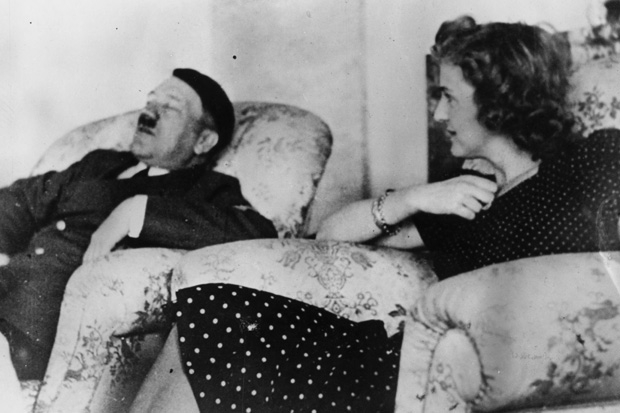I’ve heard it said that the ‘countryside’ is an urban idea, a place invented by the late Victorians in order to escape industrialisation. If so, we’re craving it more than ever. Surveys suggest 80 per cent of us now dream of living in a rural idyll. Since foxhunting was banned, riding to hounds has never been more prevalent. Suddenly five million people — most of them city dwellers — are tuning into The Archers, and viewing figures for Countryfile are higher than for The X Factor.
But perhaps the most revealing indicator of the allure of the countryside is the enduring appeal of Country Life magazine, which was founded in 1897 and is currently the subject of a three-part documentary on BBC2. It has seen its circulation rise inexorably in recent years despite remaining — just as it always was — a civilised and decorous magazine, best known for its ‘girls in pearls’ frontispiece and all that glossy country-house ‘property porn’.
Its eccentric tendencies endure — as befits the bible of the British aristocracy. When I worked there in the first half of the 1990s, the editor came up with an idea to review the latest Jaguar from an aesthete’s perspective. I was asked to set it up and so rang Sir Roy Strong, the magazine’s go-to aesthete, only to be told he couldn’t drive. I went back to the editor to report this seemingly insurmountable obstacle. ‘In that case,’ he said, ‘you do the driving and Sir Roy can do the describing.’ Weirdly, it worked.
Pitching up at Country Life was like stepping into an Evelyn Waugh novel. Everyone seemed to have an unpronounceable name (as in Cholmondeley, pronounced Chumley). I found myself cast as William Boot in Scoop, the inept young hack whose affected style was typified by the sentence ‘Feather–footed through the plashy fen passes the questing vole.’ Like Boot I would sometimes be out of my depth, such as the time I went to a black-tie dinner at a grand country house and, like a cad on the Titanic, left with ‘the ladies’ at the end of the meal, only to be summoned back to where ‘the gentlemen’ were gathered at one end of the table to talk politics over the port. Tradition dies hard in the shires.
For some of the contributors, such socialising was second nature. The Queen Mother was once drawing up a list of guests when someone suggested Country Life’s architectural historian, John Cornforth. ‘Oh no,’ she said, ‘Corners is far too grand for us.’ I don’t know about that, but Cornforth, who died in 2004, was certainly a convivial and flamboyant character who, it was rumoured, had a penchant for experimentation regarding the attire he wore in private. Chatelaines were said to lock their wardrobes when he came to stay, not least because he was ample–figured, and silk gowns tear easily.
Most of the aristocrats I met were both charming and unassuming. The Duchess of Devonshire once wrote me a thank-you note after she had done me the favour of showing me round her rare-breed pigs. But some could be irascible. On my answering machine one day was a message from an elderly peer who was returning my call and who had clearly never encountered voicemail before. He didn’t so much speak his message as bark it: ‘Carlisle here. Hello? What do you want? Hello? Bloody hell!’ This was followed by the sound of the phone being slammed down.
To others, this new technology was a revelation. Caroline Fetherstonhaugh, the editor’s brisk and formidable secretary, said its invention had made her job much easier — she could listen to the voices of the girls who might be featured on the frontispiece first, rather than having to make a decision about their suitability based on whether their house had a number. Only one numbered house passed muster with Country Life, and that was No. 1 London (Apsley House, the townhouse of the Duke of Wellington).
There has always been a friendly rivalry between Country Life (founded in 1897) and its older cousin The Spectator (1828). When The Spectator poached Country Life’s Leanda de Lisle to write a column called ‘Country life’, Country Life retaliated with a column called ‘The spectator’. But though The Spectator had its share of upmarket readers, it couldn’t really compete in the nobbiness stakes.
Neither could it boast an ‘At Home with Hitler’ feature. Having heard a rumour that there was one buried deep somewhere in the Country Life archives, I made it my mission to track it down and, to my delight, found it: the Führer proudly showing a Country Life correspondent around his lovely home, the Berghof, in 1936.
My mentor on the magazine was Lt Col Gordon Winter. He was a great raconteur, always regaling me with stories of derring-do, such as the time he won a wager in the 1930s to reach Land’s End before dawn, racing overnight in a sports car. He told me he wanted to die either falling off a horse or being shot by a jealous husband. When he did die, of a heart attack at the age of 81, it was on the back of a horse he was exercising at the Royal Mews. Remarkably, he remained in the saddle.
Three weeks later his widow received a speeding ticket. The morning he died, Gordon had been caught by a camera doing 90mph on his way from Kent to Knightsbridge. Life in the country is never dull.






Comments